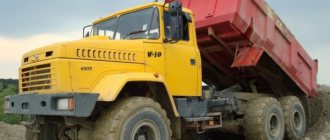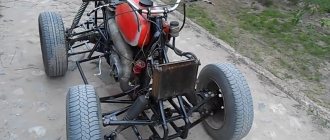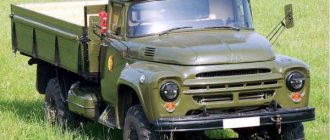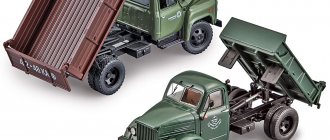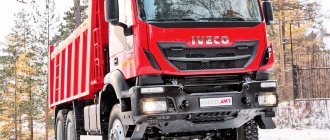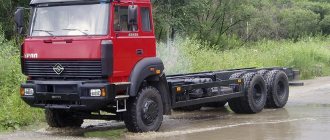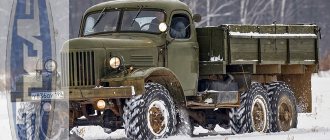A steel volumetric body placed on the chassis of the legendary army truck GAZ-66 made it possible to obtain a durable and versatile dump truck called GAZ-SAZ-3511. It was these cars, produced at the end of the last century, that became the predecessors of many modern dump trucks.
Dump truck GAZ-SAZ-3511 based on GAZ-66
For just a couple of years (from 1992 to 1994), they made this all-wheel drive dump truck with unloading on three sides. In such a short time, more than 17 thousand cars saw the light of day, which are still often found on rural and urban roads. The development (led by designer Kornilov) and assembly of the product was carried out at the Saransk dump truck plant.
The GAZ-66-31 chassis became the base for this unit. It was one of the modifications of the GAZ-66, a cabover truck that became a symbol of the Soviet era. Not a single military unit could do without these “all-terrain vehicles” - strong, unpretentious and surprisingly durable.
This truck received an eight-cylinder engine with a V-shaped arrangement of cylinders. And the fact that the cabin rose above the engine made it possible to make the unit as compact as possible, as well as to increase the area of the all-metal body. Another useful feature is all-wheel drive. And steering control was made easier for the driver by making the power steering hydraulic.
Purpose
This GAZ-66 dump truck can transport all kinds of agricultural and construction cargo on roads with any surface. Thanks to its versatility and high cross-country ability, it can easily move even off-road. Springs, which provide a smooth ride, allow you to transport fragile cargo.
At one time, these dump trucks were in the fleet of almost every agricultural enterprise. In principle, they were created specifically for agricultural needs, regularly transporting grain, hay, fertilizers and other things necessary on collective farms.
Advantages and disadvantages
Advantages of a dump truck based on GAZ-66:
- A long-lasting motor - its service life is approximately 150 thousand kilometers before the first overhaul.
- Sufficiently high cross-country ability, even in the absence of decent road surface.
- Compact and well-balanced center of gravity - the load on both axles is approximately the same.
Flaws:
- The cabin cannot boast of either spaciousness or comfort.
- The dump truck engine is not very suitable for repair.
- The curved gear shift lever is located to the right and behind the driver's seat, which causes some inconvenience when using it. This design is due to the tilting cab.
- Since the rear axle has single springs and the differential is equipped with a lock, overload can be fatal to the car.
- Unification with parts of other GAZ family vehicles is low.
- Not very large carrying capacity.
Photo of a dump truck based on GAZ-66
Engine
The GAZ-66 power engine contained a ZMZ 6606 diesel unit, which had 8 cylinders and liquid cooling. In many ways it was similar to the old engines, but it had differences: engine capacity was 4.25 liters, power was 115 horsepower. In the early 90s, an 85 horsepower engine was installed, which had a torque of 235 Nm. This unit received the name 6641. After that, the Gorky Automobile Plant put on the production line the GAZ 5441 diesel unit, which had a turbocharger. The engine had better performance and produced 116 horsepower.
External view of the GAZ 66 engine
Device
The body described below directly belongs to the dump truck; the remaining components are unified for all GAZ-66 vehicles. But there are also differences:
The power take-off for the dump truck was produced and completed at the Saransk plant. For other modifications it was made in Gorky.
The GAZ-66 had a centralized tire inflation mechanism. The dump truck was deprived of it. The tires of the rear wheels of the dump truck became double-pitch instead of single-pitch.
Body
Made entirely of metal, the body can recline on three sides (left, right and back). It has a height of 0.62 meters, but it can be doubled by adding additional wooden sides. The body is lifted using hydraulics - an NSh32U-ZL oil pump is used for this. The hydraulic reservoir is located on the right side.
Engine
The car has a diesel engine model ZMZ-66-06 with 115 horsepower (made by the Zavolzhsky Motor Plant). Note that it was designed specifically for the GAZ-66. It uses gasoline for operation, contains eight cylinders and a two-chamber K-126B carburetor. It has a closed crankcase ventilation system, liquid cooling, and direct flow oil filtration.
The use of light aluminum alloys for the main parts made the motor resistant to wear. And to make it easier to start in cold weather, there is a special pre-heater model PZHB-12.
Transmission
The four-speed (manual) gearbox has synchronization in the fourth and third stages. The main single gear is hypoid type, the clutch is dry, friction, with one disc. It is closed all the time. There is a damper mechanism on the driven disk.
There is also a transfer case (transfer case) with two stages. This transfer case consists of drive and intermediate shafts, a control mechanism, as well as drive shafts of the front and rear axles. The wheels of these drives are geared. With its help, you can downshift and also disable the front axle.
Overall dimensions of the GAZ-66 dump truck
Chassis
The all-wheel drive design assumes the presence of two drive axles. They have absolutely identical differentials and main gears (they differ only in markings). They are located in a separate housing, inserted into a special hole in the bridge beam. The cam differentials have twenty-four radial cams.
Both the front and rear suspensions are equipped with longitudinal springs in the shape of a half ellipse. The ends of these springs are fixed between rubber gaskets. There are also double-sided shock absorbers, hydraulically controlled.
Service and parking brakes are drum brakes. The separate-type working braking system is equipped with a vacuum booster. To turn it on, a hydraulic drive is used. The parking brake system (transmission) acts on all wheels.
Steering
The lower and upper parts of the steering shaft are pivotally connected to each other, and the shaft is also attached to the cabin on hinges. The steering mechanism operates by engaging the roller and the globoid worm. There is a hydraulic power steering. Its valve is located in front on the longitudinal rod, and the belt-driven pump is on the engine.
Cabin
The cabin, located above the engine, is made entirely of metal and is designed for two seats. It has a heating system and also has a glass washer. The vehicle comes with a canvas hammock bunk, which can be hung in the cabin using four hooks.
Modification
The Gorky plant produced the following types of machines:
- GAZ-66-1 – without wheel inflation system.
- GAZ-66-A – there is a winch.
- GAZ-66-B – the main window tilts up. The steering column is telescopic. The roof folded. Airborne model.
This is what GAZ 66-B looks like
- GAZ-66 – D. A power take-off is installed in the chassis.
- GAZ-66 P. tractor installed.
- GAZ-66 E. A screen with electrical equipment is installed.
- GAZ-6601 – a tire pressure regulation system is installed.
- GAZ-6605 – there is a winch and a screen.
- GAZ-6611 – GAZ-6614 – general improvements to the vehicle.
Appearance of the improved modification of GAZ 6611
The following car models were produced abroad:
- GAZ-6651;
- GAZ-6652;
- GAZ-6681;
- GAZ-6691.
We recommend watching: technical analysis of the GAZ-66
There were other versions of the car:
- AP 2, AS 66 – machine for medicine.
- DDA 2 – shower cabin for disinfection.
- GZSA 731 – van – grain, mail, medical supplies.
- Vehicle for the headquarters command.
- MZ 66 – oil tanker.
Specifications
Technical characteristics of the GAZ-SAZ-3511 dump truck based on the GAZ-66 car:
| Characteristics | Unit measurements | Indicators |
| engine's type | ZMZ-66-06 | |
| Movement speed (maximum) | 90 | km/hour |
| Load capacity (without additional sides) | 3,1 | T |
| Load capacity (with additional sides) | 2,9 | T |
| Engine power | 88,3 | kW |
| Rotational speed (nominal) | 3200 | rpm |
| Torque (maximum) | 284,4 | Nm |
| Number of engine cylinders | 8 | PC. |
| Cylinder volume | 9,2 | cm |
| Piston stroke | 8 | cm |
| Working volume | 4,25 | l |
| Fuel tank volume | 210 | l |
| Fuel consumption per 100 km | from 20 to 24 | l |
| Wheel formula | 4x4 | |
| Turning radius (maximum) | 9,5 | m |
| Front track width | 1,8 | m |
| Rear track width | 1,75 | m |
| Wheelbase | 3,3 | m |
| Clearance | 0,315 | m |
| Weight (total) | 7,25 | T |
| Weight (curb) | 4,2 | T |
| Width (over rear tires) | 2,46 | m |
| Cabin height | 2,49 | m |
| Length (full) | 6,235 | m |
| Body type | with three straight flaps | |
| Body volume (without additional sides) | 5 | m3 |
| Body volume (with additional sides) | 10 | m3 |
| Body base area | 8 | m2 |
| Body height | 0,62 | m |
| Body height with additional sides | 1,25 | m |
| Body length inside | 3,52 | m |
| Body width inside | 2,28 | m |
| Backward tipping angle | 50 | ° |
| Side tipping angle | 45 | ° |
In the video, a dump truck based on the GAZ-66 chassis:
Despite the failure with the first prototype (GAZ-SAZ-3530), the topic of “agricultural” dump trucks with a 4x4 wheel arrangement was not abandoned in Saransk, but was only suspended until a more suitable chassis became available. The start of a new stage of work on this topic was given on July 6, 1992 by the corresponding order of PA "GAZ" No. 110. Already on July 16, Technical Specifications TU 37.154.085-92 were introduced for a pilot production batch of off-road dump trucks on the GAZ-66-31 chassis, which initially received the index GAZ-SAZ-3532. In a very short time - only about a month! – a prototype of such a dump truck was built. Its design also managed to do without the use of any fundamentally new units: all the main components and parts of the dumping equipment (platform with three-way unloading, over-frame device, hydraulic cylinder, power take-off, oil tank) were widely unified with the corresponding elements of the serially produced one at that time dump truck GAZ-SAZ-3507-01. This circumstance also made it possible to agree on the production of a new dump truck without acceptance testing at all levels. Small external differences between the prototype model and subsequent experimental and production vehicles were the use of wooden extension sides (which was insignificant at this stage), as well as the presence of special cutouts to prevent contact with the rear of the frame side members when tipping backwards. On the following samples and production vehicles, to eliminate this contact, the overframe device was moved back and a platform from GAZ-SAZ-3507-02 without cutouts in the side members was used in the design.The standardization department of the NAMI Institute did not assign the original index “3532” to this vehicle, and therefore the dump truck went into production under the new designation GAZ-SAZ-3511. In the decision approved on October 26, 1992 to put into production the GAZ-SAZ-3511 dump truck under the number RTM 37.154.009-92, it was recorded that the production of this vehicle would begin simultaneously both at the Saransk Dump Truck Plant itself and at the Kyrgyz Automobile Assembly Plant in Bishkek. Previously, before the collapse of the USSR, this enterprise was known as the Frunzensky Automobile Assembly Plant. Since the late 1960s, there has been a duplicate production of Saransk dump trucks, and in almost the same volumes. Dump truck "shishigs" from Bishkek were called GAZ-KAZ-3511. Outwardly, they were very similar to the Saransk vehicles, but there were some differences: 1. On the side sides of the Saransk platforms there were four hinges per side, while the Kyrgyz vehicles had three, and the design of the hinges was also slightly different. 2. The middle longitudinal trim of the sides in Saransk was made from a trough-shaped profile, and in Frunze the longitudinal trim was made from a corner. 3. The awning fastening brackets on the sides of the GAZ-KAZ-3511 were located in the lower part of the sides, and on the SAZ they were welded between the upper and middle longitudinal trims. In addition, Kyrgyz and Saransk staples were structurally different from each other. 4. The panel of the front side of the Saransk platform was made of a flat sheet. On Kyrgyz cars it was made of a folded profile, like the side panel. 5. The design of the upper hinges of the tailgate hinge from Frunze differed in design from what was done in Saransk. 6. Rear corner posts in Saransk were made using a stamp and were a channel of variable cross-section. At KAZ, the racks were made of equal-flange channel with reinforcement of the lower part with a corner. 7. In Kyrgyz dump trucks, the rear platform tipping unit was radically different from the Saransk design - it was a tubular beam welded to the base of the platform and had at the ends rotating brackets with axles that fit into forks mounted on the rear support beam of the overframe device. In both Mordovia and Kyrgyzstan, the production of dump trucks of the “3511” model was curtailed in 1994 due to the cessation of supplies of the GAZ-66-31 base chassis. The total production volume of GAZ-SAZ-3511 and GAZ-KAZ-3511 was:

